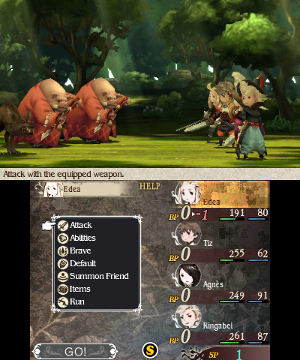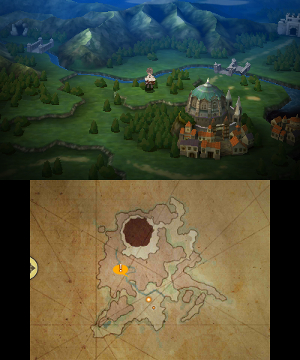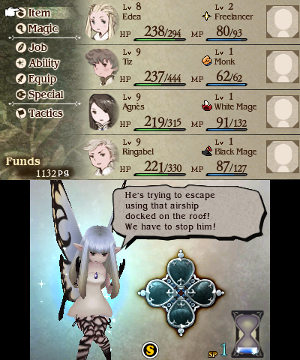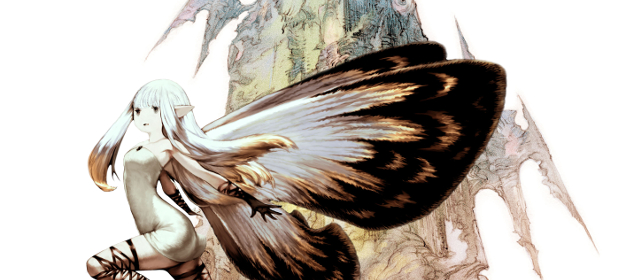It’s been some time since Final Fantasy VII finally convinced the West that JRPGs were great, leading to a renaissance of the genre from the late 90’s to the early 2000’s. Square-Enix led the charge, with Final Fantasy of course being the jewel in their role-playing crown.
But those days seem like so long ago, now. While the genre still continues to be a permanent fixture of Japanese sales charts, it has started to lose favour with gamers on the other side of the world. Other than a few notable series (Kingdon Hearts, Persona, Shin Megami Tensei, Tales), there doesn’t seem to be quite so many of these games around, and with recent Final Fantasy entries quickly becoming a mixed bag, even Square-Enix aren’t the JRPG force they used to be.
 But wait – in true JRPG style, here’s a random encounter! It’s something called a Bravely Default, and it’s using the “Mimic Final Fantasy” command successfully! A spiritual sequel to the Nintendo DS’ Final Fantasy: Four Heroes of Light, it adopts many elements of earlier entries in the series, but adds some interesting features that will appeal to RPG fans of all types.
But wait – in true JRPG style, here’s a random encounter! It’s something called a Bravely Default, and it’s using the “Mimic Final Fantasy” command successfully! A spiritual sequel to the Nintendo DS’ Final Fantasy: Four Heroes of Light, it adopts many elements of earlier entries in the series, but adds some interesting features that will appeal to RPG fans of all types.
In a story that should be familiar to anyone who played Final Fantasies I-V, the world of Luxendarc is being shrouded in darkness. Four crystals, representing the elements of Fire, Wind, Water and Earth, are losing their power, causing a global catastrophe. Each crystal is guarded by a vestal, and the Wind Vestal, Agnès Oblige, must embark on a quest to restore the crystals to their former glory and save the world from ruin. With the standard Final Fantasy tropes intact such as airships and crystals, there is a definite sense of deja vu to Bravely Default’s setting and characters, but the narrative is not without merit, mainly due to the excellent localisation and whimsical dialogue.
This cribbing of what has come before extends to the gameplay itself. Turn-based combat is the order of the day here, but there are elements that add depth to the now familiar commands. Each of your four party members is able to “store” turns using the Default command, which also acts as a defence against attacks. Storing up to three turns, you can use them all at once using the Brave command, allowing you to perform multiple commands in one single turn. Brave also allows you to take turns in advance, again allowing you to use multiple commands in one turn, but in this case that party member won’t be able to do anything until those used turns have passed.
It’s a clever way to add some tactical depth to the traditional turn-based systems of old. It’s more than possible to defeat weaker enemies in the first turn by instantly using several Brave commands, but tougher battles like boss fights may require use of the more defensive Default command and making your attacks count.
Once again in keeping with the inspiration from classic Final Fantasy, the Job system from FF III and V returns. Throughout the game, different Job Classes can be unlocked, which your party can adopt. In levelling these classes, new abilities can be earned, some of which can be assigned as a secondary Support Ability when playing as another Job Class. With this system, a melee-fighting Monk could be given some useful Black Magic spells after the Black Mage Job is suitably levelled up. This allows you to tailor your party to your style.
 So far, so old school. But these retro throwbacks are joined by a host of new features that breathe life into these worn down genre conventions. There are a variety of options to make the game suit your preferences more. Battles too slow? Set the game to fast-forward through the combat animations. Too many/too few random encounters? Tell the game to increase the encounter percentage, or turn off random encounters completely. Battles too hard? Change the difficulty to suit your abilities. The result is a JRPG that is as welcoming to newcomers as it is challenging to genre experts, especially as Bravely Default features some excellent tutorials that explain every feature and mode, as well as a Quest menu that rewards you for trying new features or abilities.
So far, so old school. But these retro throwbacks are joined by a host of new features that breathe life into these worn down genre conventions. There are a variety of options to make the game suit your preferences more. Battles too slow? Set the game to fast-forward through the combat animations. Too many/too few random encounters? Tell the game to increase the encounter percentage, or turn off random encounters completely. Battles too hard? Change the difficulty to suit your abilities. The result is a JRPG that is as welcoming to newcomers as it is challenging to genre experts, especially as Bravely Default features some excellent tutorials that explain every feature and mode, as well as a Quest menu that rewards you for trying new features or abilities.
There are also some unusual features within Bravely Default that are clearly inspired by casual mobile games. One of your party members, Tiz, is charged with rebuilding his village, which results in a mini-game where you must clear paths and erect buildings. These tasks take in-game time, so you’ll want to leave your 3DS on sleep to complete these buildings and earn regular rewards. You can also receive extra villagers to reduce the time it takes to perform tasks.
Streetpass is used in combat situations as well, and you can record commands and send them out to the world via Streetpass. These commands can be collected by others and used in their game. In addition, your own weapon-specific special moves can also be created using various parts found throughout your adventure, with even their names and associated dialogue editable. It’s a very cool idea and I can’t wait to see other player’s custom moves.
However, there is one mobile-inspired feature that I could do well without. You guessed it: micro-transactions. In combat there is a feature named Bravely Second, activated by pressing the Start button or pressing S on the Touch Screen. This is a consumable attack, which freezes the enemy and allows you to freely attack them. To earn more Bravely Second instances, you must either leave the game on sleep mode for eight hours, or pay a small fee for three SP Drinks. It’s meant for those who really struggle with the game, but there are enough ways to make the game easier already without needing to spend money.
 For a game that was released in Japan a year ago, Bravely Default sure is gorgeous. Super-deformed polygonal characters adorn environments beautifully rendered like a watercolour painting. In 3D, some areas feel like you’re walking around a beautiful pop-up book, which is an absolute joy. The occasional Augmented Reality cut-scene also impresses; with use of some included (or printable) AR cards, you can see game events play out in your surrounding environment and view them from any angle. It’s clever and it’s great to see someone actually use the 3DS’ underutilised AR features. Meanwhile, the audio keeps with traditional JRPG conventions: lots of lovely orchestral overworld tunes, sleepy town themes and exciting battle music. Quite a lot of Bravely Default’s dialogue is fully voiced as well, which combines a reasonably well-written script with some incredibly hammy voice acting, proving that not every RPG tradition works well in modern times.
For a game that was released in Japan a year ago, Bravely Default sure is gorgeous. Super-deformed polygonal characters adorn environments beautifully rendered like a watercolour painting. In 3D, some areas feel like you’re walking around a beautiful pop-up book, which is an absolute joy. The occasional Augmented Reality cut-scene also impresses; with use of some included (or printable) AR cards, you can see game events play out in your surrounding environment and view them from any angle. It’s clever and it’s great to see someone actually use the 3DS’ underutilised AR features. Meanwhile, the audio keeps with traditional JRPG conventions: lots of lovely orchestral overworld tunes, sleepy town themes and exciting battle music. Quite a lot of Bravely Default’s dialogue is fully voiced as well, which combines a reasonably well-written script with some incredibly hammy voice acting, proving that not every RPG tradition works well in modern times.
Bravely Default is also a pretty beefy game, with a ton of content and a lengthy narrative. With the difficulty options, you can make this game as easy or as hard as you want, which should please those who believe they don’t have time to play RPGs any more. I count myself as one of those people, and I haven’t been able to enjoy a game of this genre in years, until this one.
VERDICT: It’s a brave (geddit?) move on Square-Enix’s part to not stamp Bravely Default with a more popular title, because ironically, Bravely Default is one of the best Final Fantasies in years. Taking the very best of 8/16-bit entries of the series, and bringing them up to date with some beautiful graphics, clever features and engaging gameplay, this is a must for someone looking for a more traditional JRPG. On a system that has been lacking some meaty RPG action, this is a superb combination of old school gameplay with modern day additions that makes for an adventure you don’t want to miss.

SUPERB. This is the mark of greatness, only awarded to games that engage us from start to finish. Titles that score 9/10 will have very few problems or negative issues, and will deliver high quality and value for money across all aspects of their design.
Review code provided by publisher.



-1-1-85x85.jpg)


